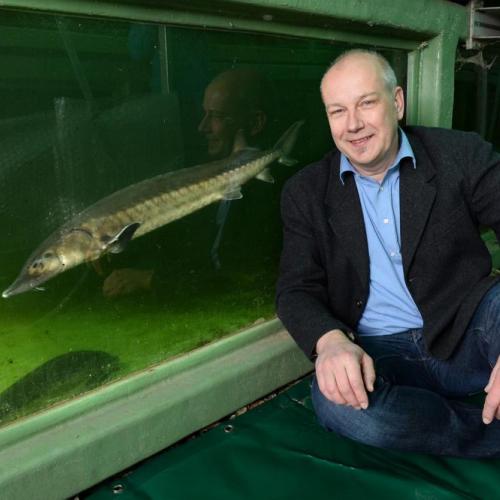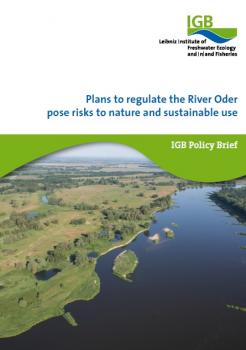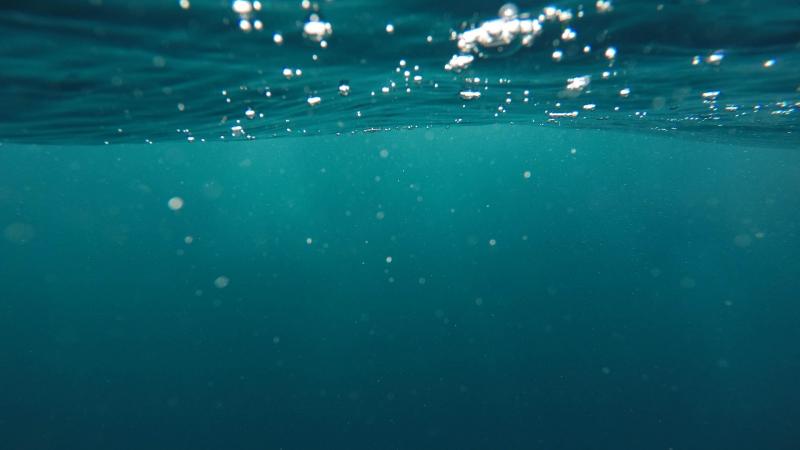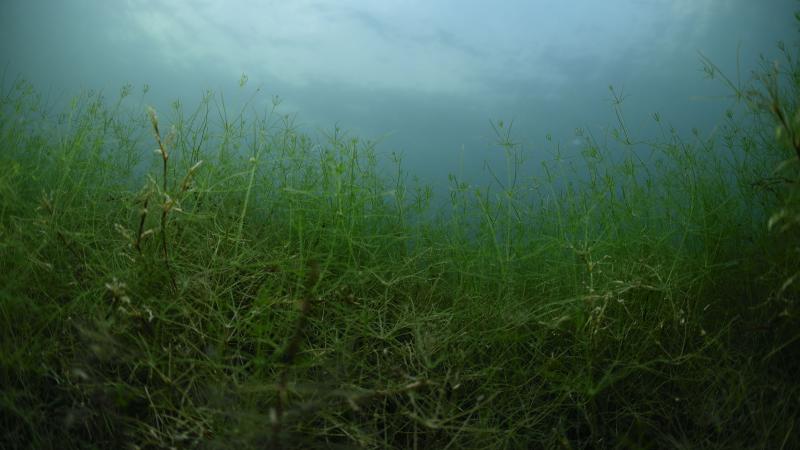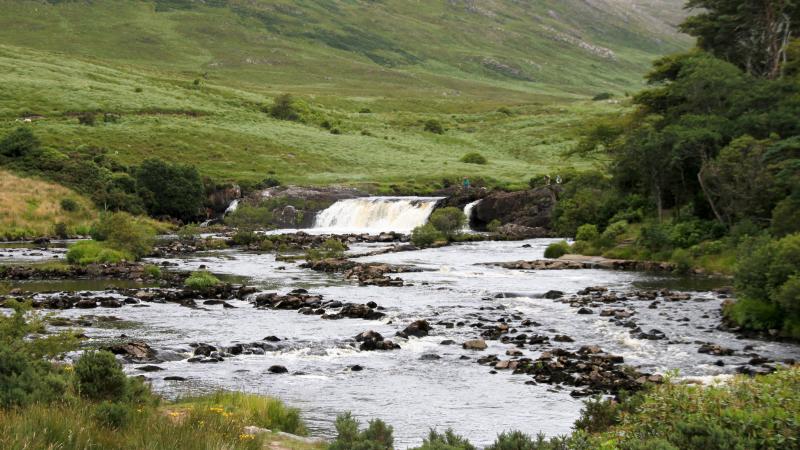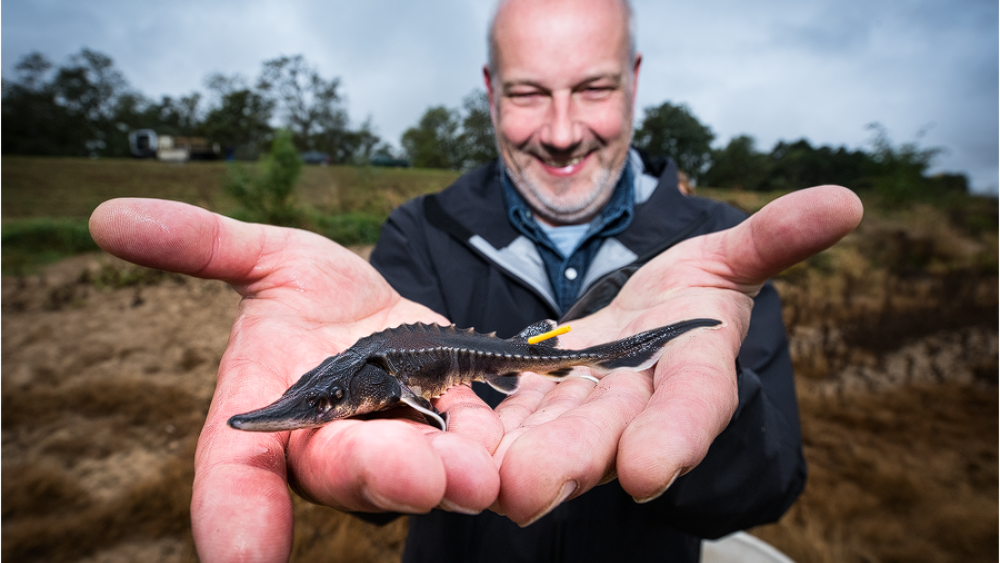
For 25 years, Jörn Geßner has been working to reintroduce the European and Baltic sturgeon to their former native habitats. This summer, the first adult animals returned to our rivers - time to take stock. | Photo: Sebastian Hennigs
This year, there was the first sighting of sturgeon that you and your team had reared and released returning to the Elbe. What makes you so sure that these fish originate from the IGB reintroduction programme?
Jörn Geßner: 1985 was the last time a mature sturgeon was caught in the Elbe, and it has been almost 30 years since once was captured in the North Sea. The fish were over two metres long, the last of their stock, since the last recorded reproduction of sturgeon in Germany was in 1964. When these young, yet mature, specimens appeared this year, we knew that they must have originated from our programme. It is an important stage victory on the long road to achieving natural species conservation.
Were you concerned that none would ever be found?
This type of work involves long waits. It takes at least twelve years for a male sturgeon – and even a few years longer for a female – to reach maturity and return to its home river. But the fact that five specimens were found in the Elbe and more than ten in the Gironde this year is a clear sign that there are likely plenty more sturgeon out there.
Can you estimate how many are out there?
We know from our French partners, who monitor the stock in the Gironde, that mortality during the first two years following release is just around 90 percent. After that, the remaining animals have survived the worst and mortality decreases sharply, we reckon to between two and five per cent each year. Mathematically speaking, this would mean that a stock of some 500 to 1,000 older fish from our programme may have survived to the present day. However, many of them will not yet have reached maturity.
Have the Elbe and its tributaries once again become an adequate habitat for the sturgeon?
Based on the findings of studies conducted in the context of restocking measures, this is indeed the case, even though the fish are not yet reproducing. The three main problem areas for the future development and reintroduction of sturgeon are fisheries, migration obstacles and river development. We are losing individuals in bycatch, for example. Although I must say that fishermen, particularly those in the North Sea, go to great lengths to prevent this from happening, and release live sturgeon that they have caught by accident. By migration obstacles, I mainly mean weirs and impoundments that are impossible or very difficult to pass. Sturgeons spawn on clean gravel banks in the lower and middle reaches of rivers. To do this, they have to leave the sea, where they spend most of their lives, and swim up the river every year. Tributaries of the Elbe such as the Saale and the Havel are inaccessible to sturgeon. There are impassable weirs at the very river mouth of the Havel, for instance. The Lower Elbe presents a different picture. In Geesthacht, for example, a fish ladder that is also passable for sturgeon was constructed at the weir in 2010. This means that they are able to migrate up to the Middle Elbe. Here the lower Mulde is now also passable, thanks to the construction of a new fishway at Dessau. But also, river development to deepen navigation channels, as in the case of the Lower Elbe, has many negative consequences for habitats, as well as a direct impact on the sturgeon.
What about the issue of water quality?
Water pollution was indeed a problem for a long time; in 19th century Hamburg, for instance, untreated wastewater was discharged into the Elbe, at one of the largest sturgeon spawning grounds, no less. This meant that spawning and juveniles were unable to develop. This was compounded by industrial waste and nutrients from agriculture, which heavily polluted the Elbe. The water in the Elbe has become much cleaner since German reunification. Some sediments remain heavily polluted to this day. Given that sturgeon spawn on gravel beds with good water circulation, however, clean flowing water – and of course the existence of gravel banks – are crucial to their survival.
…But gravel banks are under threat from the latest development plans.
That’s right. Germany’s incumbent transport minister made a bilateral agreement with the Czech Republic recently on the development of the Elbe. This agreement provides for a minimum depth of the navigation channel of 1.40 metres for pretty much the whole year and for the entire stretch of the Elbe from the Czech border to up to the tidal Elbe at Geesthacht – despite the fact that for a large section of the river a bypass via canals is already available providing safe transport conditions from Magdeburg to Geesthacht. In dry summers, the water level is currently only 50 centimetres in some places along the river. Clearly, therefore, those targets can only be achieved through interventions on a massive scale. In fact, these measures can also be expected to affect the whole ecosystem that is dependent on the Elbe. This means, for example, that by lowering the groundwater table, floodplains will be deprived of water, which will cut them – and smaller tributaries – off from the river more quickly and for longer periods of time. As a result, the deepened river will become disconnected from the floodplain, and the species that inhabit the river will lose their access to tributaries and floodplains. The previous development of the Lower Elbe already led to an increase in the risk of sturgeon colliding with ships, because these fish are found in the deeper areas of the river, and narrowing the navigation channel increases the likelihood of sturgeon being struck by the propellers of a ship. In addition, constant dredging is necessary in the Lower Elbe, involving the removal of large quantities of sediment by suction dredges. This, too, has an enormous impact on fish and other organisms.
There are also plans to develop the Oder.
There are plans to increase the depth of immersion there to 1.80 metres on at least 330 days a year, so that Category 4 vessels, i.e. really big ships, can navigate the Oder. This development would mean turning the river into a canal. The current variety of structures, such as banks and pools, is to disappear. And yet these scours are important for many fish species as resting areas and places of refuge. The sturgeon also uses them during the spawning season and for its winter quarters. Many sand and gravel banks, which provide spawning areas and habitats for all kinds of species, will disappear. The backwaters connected to the Oder will likewise lose water and be disconnected from the main river more often, meaning that plants and animals will be left with fewer and poorer-quality habitats. There will be an overall dramatic decline in fish stocks and fish diversity; and Poland’s planned development would be an absolute disaster for the sturgeon, and many other migratory fish species.
How come?
Poland plans to create 20 new impoundments, which will create a series of lakes with very little flowing sections in between. This is planned to take place from Wroclaw to the border section at Küstrin along the entire stretch of the middle Oder. Furthermore, it is intended to create a connection to the Vistula, as well as to the Black Sea via the Danube. It has not been said who actually needs this development. The only thing for sure is that the fish species native to this river will lose their last remaining semi-natural refuges forever. Poland has since started to award contracts, even though the response to the complaint filed by the Federal State of Brandenburg and the result of the environmental impact assessment on the German side are still officially pending. And let’s not forget that the German side also undertook to develop the river in a bilateral agreement with Poland – officially, it’s about ice breakup, but the facts speak a different language.
Is there any resistance to it?
There is quite considerable opposition to it in Poland, and Brandenburg has also spoken out against the development plans and lodged an objection. So far, the Federal Ministry for the Environment has been strikingly reticent on the issue of assessing the Oder development plan. In this respect, we hope to see more commitment from federal policy-makers in the future, also with respect to the envisaged Elbe project. The environment and transport ministries should coordinate more closely on this matter. IGB has provided science-based arguments against the development plans. A partial success was achieved, at least, for the Vistula, where there were plans to build a new dam. With the expert support of IGB researchers, however, several NGOs joined forces to lodge a complaint against it. The project has now had its water permit withdrawn for the time being, which will delay the plans by two years at least.
Can the development of the Oder be stopped?
Not completely, no. The extent to which the Federal Government becomes involved in this process for the German side will also play an important role. Coalition negotiations are currently underway following the Bundestag elections. I hope that an overall sensible solution can be found. Elections are coming up soon in Poland, too. There is one issue that could scupper Poland’s ambitious development plans: if implemented as planned, it will be at the expense of other transport projects, which could upset many Polish voters.
Let’s return to the topic of the sturgeon: IGB’s reintroduction programme is now in its 20th year. Can you remember how it came into being?
Actually, it’s more like a quarter of a century! It all started in 1995, when the first preliminary studies were carried out for the German Federal Agency for Nature Conservation (BfN). The focus was on how to produce an appropriate spawning stock, and to identify places where it would make sense to implement such measures. However, genetic studies of specimens from the Gironde in France – home to Europe’s last remaining natural population of sturgeon – showed that those fish were not suited to the Baltic Sea. We had no luck in the Rioni River in Georgia either, but struck lucky in Canada: there, we found a population whose genetic material was very similar to that of the Baltic sturgeon, which we were interested in. Between 2002 and 2005, we caught a total of 40 adult specimens in Canada, which we brought to Germany. At the same time, we produced juveniles in Canada in cooperation with the local fishery. The first experimental stocking programme in the Oder, involving 50 juveniles, took place in 2007. This year, we have stocked 450,000 sturgeon, bringing the total number of juveniles released into the Oder and its tributaries to a good three million. By the way, finding the sturgeon in Canada back then was a huge stroke of luck…
How come?
Because the stock characterised as optimal by our genetic studies was the only one that was still being fished commercially, allowing us to remove specimens from the stock. In the meantime, after lengthy discussions among taxonomy experts, “our” Baltic sturgeon has been recognised as the species native to the Baltic Sea. Until then, the European sturgeon, which we work with in the Elbe, was regarded as the only species present here. This process took until last year. But it had the welcome side effect of a group of experts coming together to harmonise the interests of all the participating countries. In the case of the Baltic sturgeon, the only evidence of their return so far was found in 2016: an angler caught an individual, made a note of its tag number, and put it back into the water. It was one of the older fish that we had released; it had been released into the wild at a length of 1.30 metres, where it had grown to over 2 metres in the space of seven years. The smaller fish from the stock will start returning to the river over the next few years. Since it would be futile to attempt to trace individual specimens by means of fishing, we will take DNA samples from water from the Oder next year in the hope of finding evidence of sturgeon.
What makes life difficult for the Baltic sturgeon?
The Baltic sturgeon is affected by very intensive fishing in the lagoon. The total length of bottom-set gillnets there is approx. 300 kilometres! The problem here is simply the probability of sturgeon encountering a net since the fish use the lagoon for foraging before moving to sea. Sturgeons are generally very robust. However, their ability to survive is low, given the long lengths of time that some of them are forced to spend in nets. And yet there are solutions to the problem, such as different types of net: sturgeon cannot get caught in pound nets or pots. If they were used instead of some gillnets, it would help to reduce the high mortality. Shorter immersion times of no more than 12 hours would also help ensure their survival. It is also possible to adapt the gillnets, introducing windows at the base for sturgeon to swim through. So far, fishermen in the lagoon region have refused to make such changes, arguing that perch and zander could also escape. But we’ve tested this ourselves and were unable to detect any significant impact on the catches of these two fish species. It is an unresolved problem that requires further communication, especially with the fishermen affected.
Are there any other ideas?
One solution, which is also provided for in the Helsinki Convention, would be to ban fishing altogether at certain times. But I consider that to be the worse option. After all, the fisheries sector is under pressure by decreasing stocks and resultingly declining quota anyway, and it would make more sense to work together with fishermen to find solutions.
Thinking about the future of the project, what could be done better?
Getting long-term funding is a particularly difficult issue. This is a huge difference to France, where the protection of stocks in the Gironde was linked to funding for measures adopted within a National Action Plan. They also have a coordination mechanism that enables issues related to sturgeon protection, such as gravel extraction from water bodies and habitat protection, to be regulated. I would personally like to see a similar institutionalisation and embedding at the federal level for our reintroduction programme. More than 40 projects have funded the work of the past 25 years; ultimately, however, everything often hinged on individuals.
How does the fish-rearing facility, for which IGB was promised €6.9 million in 2018, fit into this context?
These funds were approved by the Budget Committee of the Bundestag with the aim of establishing a new facility for spawning sturgeon. These funds, which were to be granted under the Federal Biological Diversity Programme, represented the investment part of the measure. At present, however, the programme’s financial situation is very tight, which is why the expected funding is being capped at that amount – it is not possible to request any funding for the operation of the facility. Since at the same time the costs for the construction project are rising every year, it can no longer be implemented on the scale as originally planned. We are currently assessing whether we can reduce the scope of the project to such an extent that it can be reasonably implemented under the given conditions and increasingly utilising sponsoring money. However, a decision on such an application would not be made until 2022, and we would need one year to complete the entire construction and approval planning, so that implementation would not be possible until 2024 at the earliest. In other words, all further planning depends on how the coalition negotiations go and on the new federal budget being passed.
How do you see the future of sturgeon in the North and Baltic Seas from a personal perspective?
I am a born optimist, else I would not have got involved in this kind of research. The European sturgeon could become a success story: England, the Netherlands and Italy also want to participate in the programme, which will enable us to achieve even more joint work. The Baltic sturgeon is also making progress. Sweden and Finland are preparing their own programmes, Russia has launched a national programme, and networking is growing. That makes it easier to communicate about protection measures. A problem that needs to be addressed quickly is the question of determining the actual losses caused by the fisheries sector. The last two or three years have shown that this could be a major weakness of the programme. Overall, we now have a much better starting point, thanks to broad collaborative research activities involving many countries, and we have the problems of sturgeon reintroduction with regard to reproduction, rearing and stocking largely under control. What poses a long-term challenge is the political accompaniment and support of our measures, i.e. issues such as stopping the development of the Oder, the construction plans for the Elbe, and changes in the fisheries sector.
The interview was conducted by Wiebke Peters.
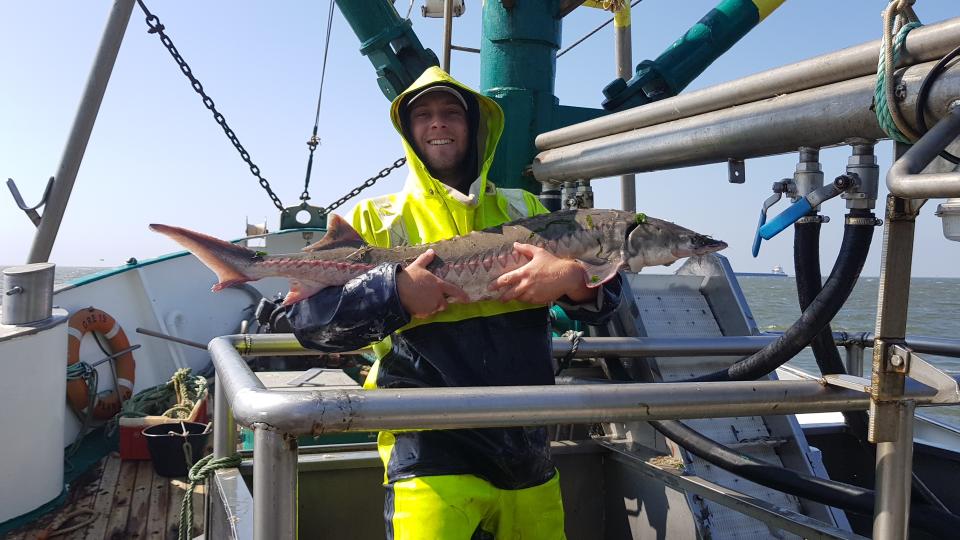
This large sturgeon was caught by fishermen near Cuxhaven and was returned alive to the water. I Photo: Jann-Tjado Gosselaar
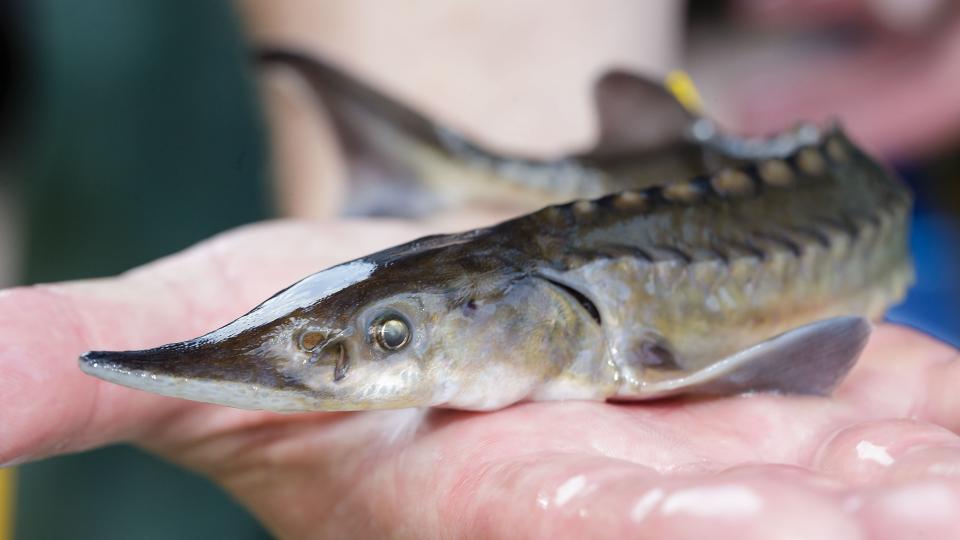
The Baltic sturgeon (Acipenser oxyrinchus): 450 000 animals have already been released into the Oder and its tributaries this year. I Photo: Marco Prosch
Specimens of the European sturgeon (Acipenser sturio) are regularly released in the Elbe. I Photo: Andrea Schmidt


